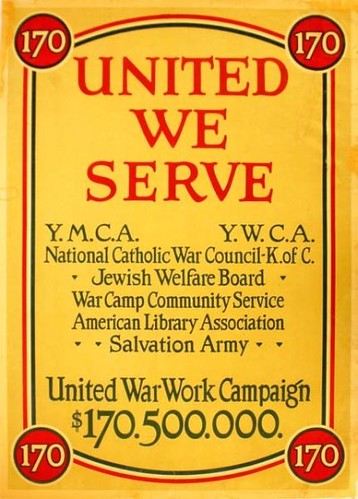As part of the ongoing exhibit of posters in Special Collections for Veterans Day, the students who created the exhibits also created entries for this blog. We will be posting these over the rest of the month of November.
1992.004.5.42 United We Serve. YMCA
The United War Work Campaign was started by President Woodrow Wilson as a drive to raise funds for seven different organizations that were assisting with the war effort in 1918. These organizations included the YMCA, YWCA, National Catholic War Council-Knights of Columbus, Jewish Welfare Board, War Camp Community Service, American Library Association, and the Salvation Army.
The plan was to raise a total of $170, 500,000 which would then be divided among the seven organizations.
The war poster, titled United We Serve, is one of the 153 World War I era posters that are housed in the University of Tulsa, McFarlin Library, department of Special Collections. There are two copies of this poster in Special Collections, and although they are given the dates 1910-1920 in the Special Collections catalogue, this poster was most likely published in 1918 . United We Stand is also one of eleven United War Work Campaign posters that are part of the collection.
This poster is a particularly unique one out of the eleven, because it is the only one that lists all seven groups and contains hardly any embellishment. The only decorative details on the poster are the red circles with the number 170 inside them, placed at each corner. These circles are connected to each other by red, white, and blue/black lines.
The artist of United We Serve is unknown. However, we can determine that this poster was made in order to encourage anyone who was not fighting in the war to support the war effort by donating money to the seven organization of this campaign.
Considering the other United War Work Campaign posters, many of which have vibrant illustrations on them, United We Stand is a fairly simple poster. And yet the big, bright red font of “United We Serve” would most certainly have attracted people’s attention. The viewer would also have no trouble in determining how much money the United War Work Campaign was asking for, due to the number 170 being repeated as well as having “$170,500,000” written in bold, black letters across the bottom of the poster. This poster may be simple, but it certainly gets its point across to its audience.
Another World War I poster that has a similar style to the United We Serve war poster is the poster titled Save by FGC, and can also be found in Special collections. Although this poster was produced by the U.S. Food Administration, the use of red and black lettering is similar to that in the United We Serve poster.
Prints of United We Serve can be found in the collections of the Missouri History Museum, located in St. Louis Missouri, and the University of Minnesota-Twin Cities. The Library of Congress also has this poster in their collection. Although a few institutions have the United We Serve poster in their collection, it is difficult to find any record of this poster ever having been published in a book or used for an exhibition. In fact, there just doesn’t seem to be much information on the United War Work Campaign poster United We Serve.
Bibliography
“$170,500,000 DRIVE FOR WELFARE WORK; President’s Plan to Aid Activities of Seven Organizationson Behalf of Our Forces.A NATION-WIDE CAMPAIGN Is Set for Week of Nov. 11–ToFollow Close After FourthLiberty Loan Appeal.” nytimes.com. Last modified September 5, 1918. http://query.nytimes.com/gst/abstract.html?res=F70611FA3F5D147A93C7A91782D85F4C8185F9.
“United we serve United War Work Campaign $170,500,000.” Library of Congress. Accessed October 8, 2012. http://www.loc.gov/pictures/item/00653186/.
“United We Serve.” flickr.com. Accessed October 6, 2012. http://www.flickr.com/photos/mfspeccoll/4903405782/.
“United We Serve. Y.M.C.A., Y.W.C.A., National Catholic War Council -K of C., Jewish Welfare Board, War Camp Community Service, American Library Association, Salvation Army. United War Work Campaign $170,500,000.” Missouri History Museum. Accessed October 8, 2012. http://collections.mohistory.org/photo/PHO:41391.
“YMCA Archives flat files collection.” Kautz Family YMCA Archives. Last modified January 24, 2012. http://special.lib.umn.edu/findaid/html/ymca/yusa0051.phtml#a2h.
— Guest post by Caroline Chandler


